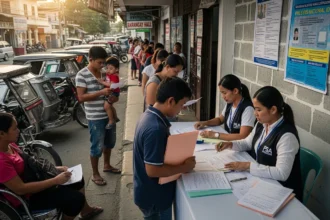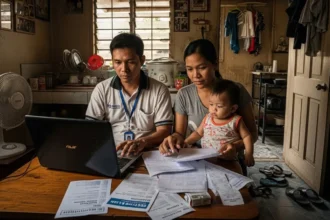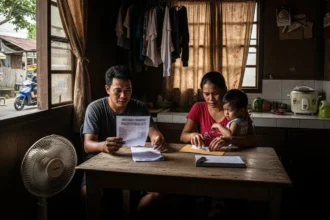There was a time when being a fan meant collecting posters and waiting for your idol’s new album on CD. Now? One hashtag can move mountains – or at least, trend worldwide in under an hour.
- 🌐 From Seoul to Manila: How K-pop Sparked a Digital Fandom Revolution
- The Rise of P-pop: From Inspiration to Filipino Pride
- 💻 The Digital Battleground: How Filipino Fandoms Built a Culture Online
- 🎧 Harmony or Rivalry? The Real Story Behind P-pop vs K-pop
- 💬 FAQs About P-pop, K-pop, and Filipino Fandom Culture
- 💙 The Future of Filipino Pop and the Digital Stage
- 🧭 References
Welcome to the era of fandoms. 💥
In the Philippines, K-pop built a generation of dreamers – from copying dance steps in front of mirrors to streaming songs at 3 a.m. with stan accounts and lightsticks glowing in the dark. Then came P-pop, proudly Filipino but inspired by the same passion and precision. Groups like SB19, BINI, and Alamat didn’t just perform – they sparked pride, proving that we can do pop our way, too.
But the real revolution? It’s happening online. Fans turned social media into their concert halls – trending hashtags, creating fancams, editing memes, and defending their idols like family. What used to be a casual hobby is now a full-blown digital culture, where belonging means more than just liking the same music – it’s identity.
Because whether you stan BTS or SB19, one thing’s for sure: fandom is no longer just about who you cheer for. It’s about who you are in this connected, chaotic, and colorful Filipino online world.
🌐 From Seoul to Manila: How K-pop Sparked a Digital Fandom Revolution
Before we had lightsticks and fancams, we had cassette tapes, MYX countdowns, and CDs from Odyssey. Back then, fandom was simple – you liked a band, you bought their album, you sang their hits at karaoke. Walang pa-trending, walang fancam wars. Just pure enjoyment.
Then came K-pop – and everything changed. 🎤
🎶 The K-pop Wave Hits the Philippines
When Super Junior first performed “Sorry, Sorry,” Filipinos copied the dance steps faster than you could say “Aegyo.” 2NE1 became icons (especially because of Dara, our own Sandara Park). And soon, BIGBANG, EXO, and BTS were dominating not just charts, but our hearts – and timelines.
Suddenly, fandom wasn’t a hobby anymore – it became a full-time lifestyle:
- Twitter threads turned into news outlets. Fans updated faster than showbiz reporters.
- YouTube became a classroom. We learned choreography, Korean phrases, and even editing for fancams.
- Facebook and TikTok became fan arenas. From dance covers in Ayala malls to viral trend remakes, everyone wanted in.
- Charity drives replaced clout. Filipino K-pop fans donated rice, built classrooms, and planted trees in the names of their idols.
K-pop didn’t just bring music – it brought organization, creativity, and purpose.
💻 The Digital Blueprint of Fandom
Here’s the thing – K-pop fandoms were the first to truly master the digital world.
They built a blueprint every other fandom (including P-pop) would later follow:
- Hashtags as Battle Flags.
Every comeback meant war – trending worldwide, coordinating time zones, setting alarms to tweet at the exact minute of release. - Streaming as Discipline.
Streams weren’t passive; they were mission-based. Fans created guides: “Play the MV 10x a day, skip ads after 30s, don’t mute!” 😂 - Engagement as Power.
Likes, comments, and shares weren’t just interactions – they were votes in the court of global attention. - Unity as Identity.
Whether ARMY, BLINK, or CARAT, Filipino fans built communities that felt like families. Stan accounts celebrated birthdays, comforted each other, and organized fan meets in cafés with photocards and banners.
It wasn’t just entertainment – it was belonging.
🌏 From Korean Beats to Filipino Dreams
The K-pop wave didn’t erase Filipino identity – it inspired it.
It showed young Filipinos that world-class talent could come from anywhere. That production value, discipline, and fan culture could turn any stage – even a barangay hall or a YouTube channel – into a global platform.
By the mid-2010s, that inspiration became transformation.
Filipino trainees started forming their own groups, carrying the same fire and precision, but with lyrics and stories that hit closer to home.
K-pop didn’t just dominate – it planted a seed.
And that seed? Grew into P-pop. 🌱
The Rise of P-pop: From Inspiration to Filipino Pride
K-pop may have taught us how to dream big – but P-pop showed us how to dream our own way.
When SB19 debuted, nobody expected five ordinary Filipino guys to spark a cultural revolution. But they did – through talent, grit, and Tagalog lyrics that hit straight to the puso. Their songs like “MAPA” and “What?” carried the same intensity as any global hit, yet every line sounded like it came from us.
Then came BINI, proving that girl power is alive and slaying in pastel colors and polished choreography. Alamat mixed regional languages and cultural roots, proudly breaking stereotypes of what “pop” should look and sound like. And newcomers like G22, VXON, and KAIA continue to push that energy forward – merging style, storytelling, and soul.
💫 From Imitation to Innovation
Let’s be honest – early on, people said P-pop was just “K-pop copycat.” But that’s the magic of evolution: we borrowed the structure, then gave it a Filipino heartbeat.
- Lyrics that heal. P-pop uses the emotional depth of OPM – hugot lines mixed with pop melodies that still make you cry.
- Stories that represent us. Their visuals feature jeepneys, Filipino words, and hometown backdrops instead of foreign skylines.
- Fans that feel like family. A’TINs, Blooms, Magiliw, and other fandoms rally not just for views – they rally for Filipino pride.
This isn’t imitation anymore – it’s reclamation.
We learned the rules of K-pop… then wrote our own.
🌈 The Movement, Not Just the Music
P-pop isn’t just about beats or choreography – it’s a mirror of who we are today: digital, creative, resilient, and bursting with Pinoy energy.
You’ll see it in how fans trend “#StanPpop” weekly, how TikTok challenges keep local songs alive, and how international fans now watch Tagalog lyric videos with subtitles because, why not?
The world is finally starting to notice.
And it’s not because we shouted the loudest – it’s because we sang with sincerity.
From Bayanihan to Stan-ihan, Filipino fandom culture proved one thing:
we don’t need to be like anyone else to be world-class.
💻 The Digital Battleground: How Filipino Fandoms Built a Culture Online
If there’s one thing Filipinos do best – it’s making noise online. 😅
But behind every hashtag war and trending topic is something deeper – a community built on love, loyalty, and pure digital strategy.
In the world of P-pop vs K-pop, the internet isn’t just a platform – it’s the new stage, the new concert hall, and sometimes, the new boxing ring.
🧠 From Fans to Digital Strategists
P-pop and K-pop fans don’t just scroll – they mobilize. These are no ordinary netizens; these are people who know analytics better than some marketing teams.
They know how to:
- Trend a hashtag worldwide within minutes (thanks to mass tweet coordination groups).
- Boost streaming counts using fan-curated guides – “Play but don’t loop, skip ads after 30s!”
- Vote across multiple apps during award seasons, using different email accounts and VPNs like pros.
- Design campaigns with visuals, posters, and countdowns that look more polished than actual PR teams.
Filipino fans are some of the most organized in the world. They can turn what looks like chaos into a full-scale digital operation.
Because for them, fandom isn’t random – it’s purposeful passion.
❤️ Bayanihan Meets Stan Culture
There’s a saying that Filipinos can make community out of anything. Online fandoms proved that true in every sense.
When SB19 drops a comeback or BTS releases a new track, timelines transform overnight into volunteer centers. People divide tasks – “ikaw sa streaming party,” “ako sa design,” “ako sa giveaways.”
And here’s what’s beautiful: these aren’t paid promoters – they’re volunteers moved by love and national pride.
Filipino fandom culture mirrors Bayanihan, that innate drive to help and uplift others. Except this time, instead of lifting a bahay kubo, we’re lifting hashtags, views, and morale.
Many fandoms even do charity work in their idols’ names –
- Tree-planting drives for Earth Day 🌱
- Fundraisers for typhoon victims 🌊
- Donation campaigns for schools or local communities 🏫
It’s entertainment with empathy – fame with purpose.
📱 The Great Online Arena
Social media is both playground and battleground.
On a good day, it’s filled with joy, edits, and laughter. On a bad day… well, let’s just say stan Twitter can be a war zone. ⚔️
Filipino fans defend their idols fiercely – sometimes too fiercely. “Fan wars” happen, sure, but underneath the noise is proof of how deeply Filipinos feel. We invest emotionally in the artists who move us. That same intensity that makes us cry over teleseryes? Yup – it lives online now.
But the good news is, as fandoms mature, so does the conversation. More and more fans are choosing collaboration over competition – cross-fandom streaming parties, unity hashtags like #SupportPpop or #AsiaInHarmony, and even joint events celebrating both K-pop and P-pop groups.
Because at the end of the day, they know the real competition isn’t each other – it’s apathy.
And Filipino fans? We don’t do apathetic. We care – loudly, proudly, and all the way to the trending tab. 💪
🌍 The Global Ripple Effect
This digital passion didn’t go unnoticed. Korean entertainment companies praise Filipino fans for their loyalty. P-pop groups like SB19 and BINI now trend not only in Manila but in countries like Thailand, Indonesia, and Brazil – thanks to the dedication of online fans.
Streaming numbers that once seemed impossible for local acts are now a norm. You’ll even see foreigners posting reaction videos to Tagalog songs, subtitles and all, saying: “Filipinos, you’ve got something special here.”
And they’re right. We do. Because the Filipino fandom isn’t just about “stanning” – it’s about showing the world who we are: passionate, united, creative, and endlessly hopeful.
In the end, every trending hashtag, every fan project, every late-night streaming session tells a single story:
that love, when amplified by technology, can turn a small fandom into a national movement.
🎧 Harmony or Rivalry? The Real Story Behind P-pop vs K-pop
Every few months, social media flares up:
“P-pop vs K-pop – who’s better?”
Comments flood in, threads go wild, and fans passionately defend their favorites. But when you really look closely, it’s not a battle – it’s a conversation.
Let’s be honest – Filipino fans are some of the most loyal in the world. When we love, we love hard. So when P-pop started gaining recognition, it was natural for people to draw comparisons. The choreography, styling, and production value – all reminiscent of Korean pop perfection. But what others see as imitation, fans see as evolution.
💬 Different Origins, Shared Passion
- K-pop was built on precision – years of training, strict systems, and synchronized excellence.
- P-pop, on the other hand, was built on heart. It carries the warmth, humor, and emotional vulnerability that define Filipinos.
Both celebrate expression – one polished like a diamond, the other raw but full of soul.
Where K-pop thrives in discipline and visual storytelling, P-pop blooms in emotion and relatability. It’s like comparing kimchi and adobo – both delicious, both proud of where they came from.
💞 From Rivalry to Respect
The truth is, most P-pop groups grew up loving K-pop.
SB19 themselves trained under a Korean company before becoming local icons. Many idols openly stan BTS, BLACKPINK, or EXO – not to compete, but to honor the blueprint.
And Filipino fans? They can love both.
You’ll see people tweeting:
“Streaming BINI’s new MV while watching Stray Kids comeback. Multistan life is hard, pero worth it!” 😂
It’s not rivalry anymore – it’s reciprocal admiration.
Both sides are learning from each other:
- P-pop groups adopt K-pop’s professionalism.
- K-pop artists admire Filipinos’ warmth and community spirit.
Even Korean agencies are now scouting in the Philippines, drawn by our mix of talent and passion.
🤝 The Bigger Picture: Asian Unity
The world used to look west for entertainment, but now it’s Asia’s turn. 🌏
K-pop broke the global wall – now P-pop is proving that Southeast Asia has its own rhythm, its own voice.
Instead of “vs,” maybe it’s time we said “and.”
K-pop and P-pop.
Two different melodies, one shared heartbeat.
Because whether it’s a Korean song that makes you cry or a Filipino anthem that makes you proud, the point isn’t who wins – it’s that Asian music finally has the world’s attention.
And for Filipinos, that’s not competition.
That’s representation. 🇵🇭❤️🇰🇷
💬 FAQs About P-pop, K-pop, and Filipino Fandom Culture
1. What’s the difference between P-pop and K-pop?
K-pop (Korean Pop) focuses on polished production, strict training systems, and synchronized performance – it’s like watching perfection on stage. P-pop (Pinoy Pop), on the other hand, blends that discipline with Filipino emotion, humor, and storytelling. It’s pop with hugot. Both genres share the same love for performance but express it through different cultural lenses.
2. Who are the top P-pop groups in the Philippines right now?
As of today, groups like SB19, BINI, Alamat, G22, and KAIA are leading the charge. SB19 opened the door for local idol culture to thrive, while BINI brought empowerment and grace. Alamat stands out for singing in regional languages, proudly showcasing cultural diversity. Each group carries its own flavor – all equally Filipino, all equally world-class.
3. Is P-pop inspired by K-pop?
Yes – but in the same way students are inspired by their teachers. K-pop gave structure, training, and production standards that P-pop later adapted and made its own. Many Filipino artists trained under Korean systems before creating music rooted in local stories and identity. P-pop is the child that honors its roots but speaks its own language.
4. Why do Filipinos love K-pop so much?
Because K-pop reflects the same things Filipinos value – passion, teamwork, and emotional storytelling. Beyond the visuals and choreography, it’s the connection that draws people in. Fans see hardworking idols chasing dreams – something deeply relatable to the Filipino experience. It’s art that feels both foreign and familiar.
5. How did social media influence P-pop and K-pop fandoms in the Philippines?
Social media turned fandoms into full-blown digital movements. Fans no longer just watch – they participate through hashtags, fancams, streaming goals, and online fan projects. Platforms like Twitter, TikTok, and YouTube became both stage and battleground. It gave every Filipino fan a voice, and collectively, that voice now echoes worldwide.
6. Are Filipino K-pop fans also supporting P-pop?
Absolutely! In fact, many Filipino K-pop fans were among the first to push for P-pop recognition. They used their knowledge of streaming, voting, and online promotion to support local acts like SB19 and BINI. For them, it’s not competition – it’s growth. Supporting both scenes means celebrating Asia’s rise in global music.
7. How does P-pop promote Filipino culture?
Through music, language, and visual storytelling. P-pop groups proudly weave Tagalog, Bisaya, and even Ilocano into their lyrics, showcasing the diversity of the Philippines. Music videos feature local landmarks, traditional motifs, and distinctly Pinoy stories. It’s entertainment that carries culture – proof that global sound can still speak with a local heart.
8. Is it true that P-pop is gaining international fans?
Yes! The “Pinoy sound” is slowly finding its place abroad. SB19 has performed internationally, while BINI and Alamat are earning recognition across Asia and Latin America. Reaction videos from global fans are increasing, with many saying Filipino groups bring a fresh, emotional flavor to the pop scene. The world is listening – and it’s about time.
9. What makes Filipino fandoms unique compared to other countries?
Filipino fandoms are powered by heart and humor. They treat fandom like family – organizing meetups, donation drives, and even birthday projects for idols. There’s this rare mix of chaos and care that makes it feel like home. Other countries have fans; we have communities.
10. What’s the future of P-pop in the Philippines?
Bright – and getting brighter. The industry is growing, production quality is leveling up, and new groups debut every year. As long as Filipino fans keep showing up and supporting local music, P-pop will continue to rise. It’s more than a trend – it’s a movement, and we’re living it in real time.
💙 The Future of Filipino Pop and the Digital Stage
If there’s one thing P-pop vs K-pop has taught us, it’s that music isn’t a competition – it’s a conversation. What started as admiration grew into inspiration, and now, collaboration. Filipinos learned from Korean idols how to dream big, and in return, we showed the world that sincerity and soul can hit just as hard as precision and perfection.
Our artists are no longer just “catching up.” They’re creating – writing stories that sound like home, blending languages that reflect who we are. And our fandoms? They’re the heartbeat that keeps it all alive – proof that in this digital age, connection is the new applause.
Someday, when people talk about Asian pop culture, they won’t just mention Seoul or Tokyo. They’ll say Manila. Because the truth is simple – the world is starting to hear what we’ve known all along: Filipinos were born to perform, to feel, and to be heard.
🧭 References
-
SunStar PH – Influence of K-Pop in the Rise of P-Pop
-
Asian Journal – Emergence of P-pop as a New Filipino Voice
-
GRID Magazine – Filipino Pop Music Deep Dive
-
Billboard Philippines – How P-Pop is Re-Shaping Filipino Music
-
Vista Residences – The Rise of P-Pop Groups
-
Media Meter – Popular P-pop Groups in the Philippines 2025










